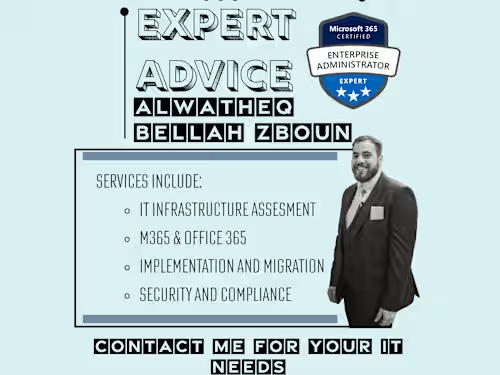
IT Strategy and Consulting
Starting at
$
150
/hrAbout this service
Summary
FAQs
What is the purpose of your IT strategy and consulting service?
The service aims to align your IT infrastructure with your business goals through assessment, strategy development, and implementation of optimized solutions.
What can I expect during the initial consultation?
I will discuss your business goals and current IT infrastructure to define the project scope and gather necessary information.
How long does the IT strategy development process take?
It varies depending on complexity but typically takes a few weeks to a couple of months. A detailed timeline will be provided during the consultation.
What types of businesses can benefit from this service?
Businesses of all sizes and industries, from small to medium-sized enterprises to large corporations, can benefit from my services.
What deliverables can I expect?
Deliverables include an IT strategy, technology recommendations, a digital transformation plan, a cloud strategy, security framework, and implementation support.
How do you ensure security and compliance?
I conduct security assessments and develop a compliance strategy adhering to industry standards like GDPR and HIPAA.
Can you help with cloud migration and management?
Yes, I provide cloud strategy and migration services, including ongoing management and support.
What kind of training do you provide?
I offer customized training sessions and comprehensive documentation to ensure your IT staff can manage the new infrastructure.
How do you handle cost optimization?
I analyze current IT spending and implement cost-saving strategies to achieve a more efficient IT environment.
What's included
Initial Assessment Report
• Comprehensive review of the current IT infrastructure. • Identification of strengths, weaknesses, opportunities, and threats (SWOT analysis). • Detailed analysis of existing systems, applications, and workflows.
Business Requirements Document
• Detailed documentation of business goals and objectives. • Identification of key stakeholders and their requirements. • Analysis of current and future business needs.
IT Strategy Development
• Creation of a tailored IT strategy aligned with business goals. • Roadmap for technology adoption and innovation. • Prioritization of IT projects and initiatives.
Technology Recommendations
• Evaluation and recommendation of appropriate technologies and solutions. • Cost-benefit analysis of proposed technologies. • Vendor selection and comparison.
Digital Transformation Plan
• Detailed plan for digital transformation initiatives. • Identification of key projects and timelines. • Change management strategy to ensure smooth transition.
Cloud Strategy and Roadmap
• Cloud adoption and migration strategy. • Selection of appropriate cloud services and providers. • Implementation plan with timelines and milestones.
Security and Compliance Framework
• Security assessment and risk management plan. • Compliance strategy for relevant regulations (e.g., GDPR, HIPAA). • Implementation of security best practices and tools.
IT Governance Model
• Development of IT governance policies and procedures. • Framework for IT decision-making and accountability. • Metrics and KPIs for measuring IT performance.
Business Continuity and Disaster Recovery Plan
• Development of business continuity strategies. • Disaster recovery plan with detailed procedures. • Regular testing and updating of the recovery plan.
Cost Optimization Report
• Analysis of current IT expenditures. • Recommendations for cost-saving measures. • Implementation plan for cost optimization.
Implementation Support
• Assistance with the implementation of recommended strategies. • Project management and coordination. • Regular progress updates and status reports.
Training and Knowledge Transfer
• Training sessions for key stakeholders and IT staff. • Documentation and knowledge transfer to ensure self-sufficiency. • Ongoing support and resources.
Executive Summary
• High-level summary of findings, recommendations, and strategic plans. • Presentation to executive leadership and key stakeholders. • Q&A session to address any concerns and provide clarifications.
Recommendations
(5.0)


Client • Jan 25, 2025
Recommended
Watheq has been a great asset in our infrastructure projects, filling in as needed to provide needed expertise. Watheq is a highly skilled expert in Microsoft technologies, consistently demonstrating in depth knowledge and hands on experience in managing and optimizing enterprise environments with such tools as Intune, Windows Hello for Business, Entra, Active Directory and Windows server.





